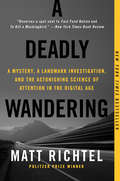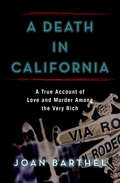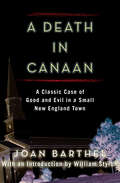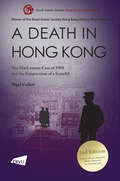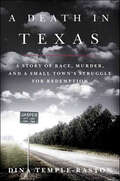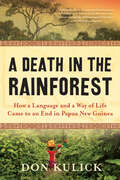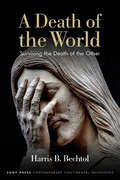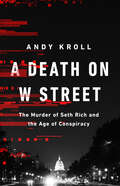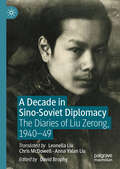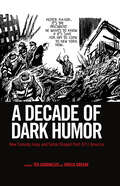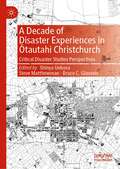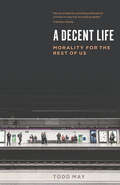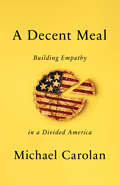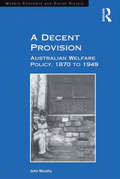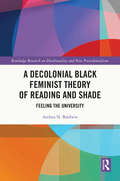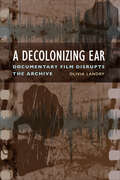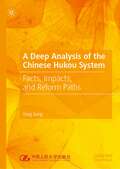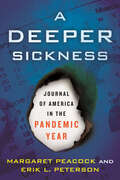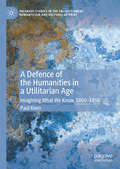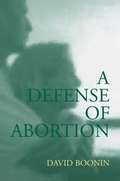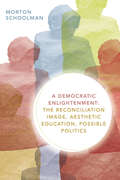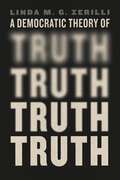- Table View
- List View
A Deadly Wandering
by Matt RichtelA landmark exploration of the vast and expanding impact of technology, rivetingly told through the lens of a deadly collisionOne of the year's most original and masterfully reported books, A Deadly Wandering by Pulitzer Prize-winning New York Times journalist Matt Richtel interweaves the cutting-edge science of attention with the tensely plotted story of a mysterious car accident and its aftermath to answer some of the defining questions of our time: What is technology doing to us? Can our minds keep up with the pace of change? How can we find balance? Through Richtel's beautifully constructed narrative, a complex and far-reaching topic becomes intimate and urgent--an important call to reexamine our own lives.On the last day of summer, an ordinary Utah college student named Reggie Shaw fatally struck two rocket scientists while texting and driving along a majestic stretch of highway bordering the Rocky Mountains. Richtel follows Reggie from the moment of the tragedy, through the police investigation, the state's groundbreaking prosecution (at the time there was little precedent to guide the court), and ultimately, Reggie's wrenching admission of responsibility. Richtel parallels Reggie's journey with leading-edge scientific findings regarding human attention and the impact of technology on our brains--showing how these devices, now thoroughly embedded into all aspects of our lives, play to our deepest social instincts and prey on parts of the brain that crave stimulation, creating loops of compulsion, even addiction. Remarkably, today Reggie is a leading advocate who has helped spark a national effort targeting distracted driving, and the arc of his story provides a window through which Richtel pursues actionable solutions to help manage this crisis individually and as a society. A propulsive read filled with fascinating scientific detail, riveting narrative tension, and rare emotional depth, A Deadly Wandering is a book that can change--and save--lives.
A Death in California: A True Account of Love and Murder Among the Very Rich
by Joan BarthelA troubled Los Angeles socialite is both terrorized and tempted by a killer in this &“brilliantly written&” true story by the author of A Death in Canaan (Ann Rule). Hope Masters lived in one of the most exclusive neighborhoods in Beverly Hills—but was entitled to food stamps. Pretty, petite, and privileged, she was recovering from two failed marriages and a string of poor decisions. But when Hope met and fell in love with a handsome advertising executive, she believed her life was finally back on track—until the morning she woke up to find the barrel of a gun in her mouth. Hope&’s fiancé lay dead in the next room. His killer was a new acquaintance who&’d been visiting the couple in a remote ranch in the foothills of the Sierra Nevada mountains. He claimed to be a journalist, but his real identity was as mysterious as his motivations. Even more bizarre, however, was what happened at the end of the long, nightmarish weekend in which Hope saw everything she cared about destroyed: She began to fall in love with her tormenter. A fascinating and frightening portrait of the power of evil to lead the most innocent of victims down the darkest of paths, A Death in California is &“a first-rate piece of reporting&” (Kirkus Reviews) on &“one of the strangest cases in the annals of American crime&” (The New York Times).
A Death in Canaan: A Classic Case of Good and Evil in a Small New England Town
by Joan BarthelA &“riveting&” true crime classic: The trial of Connecticut teen Peter Reilly, accused of killing his mother, and the community that defended him (People). In the sleepy hamlet of Canaan, Connecticut, Barbara Gibbons stood out. She and her eighteen-year-old son, Peter Reilly, lived in a drab one-bedroom house on a desolate stretch of road. An intelligent, lively woman with a wicked sense of humor, Barbara also had dark moods and drank too much. She fought loudly with neighbors and her son, and appeared to have a messy, complicated love life. When Peter came home from the Teen Center one night to discover his mother lying naked on the bedroom floor with her throat slashed, the police made him their prime suspect. After eight hours of interrogation and a polygraph test, Peter confessed. Investigators were convinced they had an open-and-shut case, but the townspeople disagreed. They couldn&’t believe that the naïve teenager was capable of such a gruesome crime, and blamed detectives for taking advantage of the boy&’s trust. With the help of celebrities including Mike Nichols and William Styron, who contributes an eloquent and persuasive introduction to Joan Barthel&’s account of the case, the community of Canaan rallied to Peter&’s defense. A gripping murder mystery and an intimate portrait of the loyalties, resentments, and secrets lurking beneath the placid surface of quiet towns across America, A Death in Canaan is a masterpiece of &“first-class journalism&” (The New York Times).
A Death in Hong Kong: The MacLennan Case of 1980 and the Suppression of a Scandal (2nd Edition) (Royal Asiatic Society Hong Kong Studies)
by Nigel CollettIn January 1980, a young police officer named John MacLennan committed suicide in his Ho Man Tin flat. His death came mere hours before he was to be arrested for committing homosexual acts still, at that point, illegal in Hong Kong. But this was more than the desperate act of a young man, ashamed and afraid; both his death and the subsequent investigation were a smokescreen for a scandal that went to the heart of the establishment. MacLennan came to Hong Kong from Scotland during a tumultuous time in Hong Kong's history. The governorship of Sir Murray MacLehose was to be a time of reform and progress, but with that remit came the determination of many to suppress scandals and silence those who stirred up trouble. Both the life and death of John MacLennan seemed to many of those in power to threaten the stability of one of Britain's last colonies. The second edition includes a foreword by Christine Loh (former undersecretary for the environment, former legislator, and founder of Civic Exchange) as well as updated information from new interviews with key people involved in the case. With endorsements from human rights researchers and the local community, this book provides insight into Hong Kong during a time of social unrest and corruption scandals, a time when homosexuality and paedophilia were often considered interchangeable and both offered easy targets for blackmail.
A Death in Texas: A Story of Race, Murder, and a Small Town's Struggle for Redemption
by Dina Temple-RastonAn extraordinary account of how a small Texas town struggled to come to grips with its racist past in the aftermath of the brutal murder of James Byrd, Jr.On June 7, 1998, a forty-nine-year-old black man named James Byrd, Jr., was chained to the bumper of a truck and dragged three miles down a country road by a trio of young white men. It didn't take long for the residents of Jasper, Texas, to learn about the murder or to worry that the name of their town would become the nation's shorthand for hate crimes. From the initial investigation through the trials and their aftermath, A Death in Texas tells the story of the infamous Byrd murder as seen through the eyes of enlightened Sheriff Billy Rowles. What he sees is a community forced to confront not only a grisly crime but also antebellum traditions about race. Drawing on extensive interviews with key players, journalist Dina Temple-Raston introduces a remarkable cast of characters, from the baby-faced killer, Bill King, to Joe Tonahill, Jasper's white patriarch who can't understand the furor over the killing. There's also James Byrd, the hard-drinking victim with his own dark past; the prosecutor and defense attorneys; and Bill King's father, who is dying of a broken heart as he awaits his son's execution.Just as Bernard Lefkowitz pulled back the curtain on Glenridge, New Jersey, in his classic work Our Guys, Temple-Raston goes behind the scenes in Jasper, Texas, to tell the story of a town where racism and evil made itself at home
A Death in Texas: Race, Murder and a Small Town's Struggle for Redemption
by Dina Temple-RastonFrom the initial investigation through the trials and their aftermath, A Death in Texas tells the story of the infamous Byrd murder as seen through the eyes of enlightened Sheriff Billy Rowles. What he sees is a community forced to confront not only a grisly crime but also antebellum traditions about race. Drawing on extensive interviews with key players, journalist Dina Temple-Raston introduces a remarkable cast of characters, from the baby-faced killer, Bill King, to Joe Tonahill, Jasper's white patriarch who can't understand the furor over the killing. There's also James Byrd, the hard-drinking victim with his own dark past; the prosecutor and defense attorneys; and Bill King's father, who is dying of a broken heart as he awaits his son's execution.
A Death in the Rainforest: How a Language and a Way of Life Came to an End in Papua New Guinea
by Don KulickOne of Time’s 32 Books You Need to Read This Summer“A profoundly human story about a seemingly exotic and strange place that really isn't so strange at all.” —Carl Hoffman, author of The Last Wild Men of Borneo As a young anthropologist, Don Kulick went to the tiny village of Gapun in New Guinea to document the death of the native language, Tayap. He arrived knowing that you can’t study a language without understanding the daily lives of the people who speak it: how they talk to their children, how they argue, how they gossip, how they joke. Over the course of thirty years, he returned again and again to document Tayap before it disappeared entirely, and he found himself inexorably drawn into their world, and implicated in their destiny. Kulick wanted to tell the story of Gapuners—one that went beyond the particulars and uses of their language—that took full stock of their vanishing culture. This book takes us inside the village as he came to know it, revealing what it is like to live in a difficult-to-get-to village of two hundred people, carved out like a cleft in the middle of a tropical rainforest. But A Death in the Rainforest is also an illuminating look at the impact of white society on the farthest reaches of the globe—and the story of why this anthropologist realized finally that he had to give up his study of this language and this village. An engaging, deeply perceptive, and brilliant interrogation of what it means to study a culture, A Death in the Rainforest takes readers into a world that endures in the face of massive changes, one that is on the verge of disappearing forever.
A Death of One's Own
by Gerda LernerA touching memoir of a marriage, a family in crisis, a man faced with death. Riveting, beautifully written, profoundly moving. A testimonial to love, courage, and honesty.
A Death of the World: Surviving the Death of the Other (SUNY series in Contemporary Continental Philosophy)
by Harris B. BechtolOffers a description of what happens to survivors after a death, based on the effect this death has on the survivor's relation to the spatial and temporal world occupied after the loss of the deceased.A Death of the World offers a phenomenological description of what happens to the world for those who survive the death of someone. Bringing Jacques Derrida's works into conversation with the philosophies of Martin Heidegger, Emmanuel Levinas, Jean-Luc Marion, Maurice Blanchot, and Claude Romano; the poetry and literature of Paul Celan, W. H. Auden, Emily Dickinson, Ovid, and Jonathan Safran Foer; and psychological works concerning trauma, mourning, epigenetics, and memory, author Harris B. Bechtol provides interdisciplinary language for understanding the death of the other as an event. He argues that such death must be understood as an event because this death is more than just the loss of the other who has died insofar as the meaning of the world to and with this other is also lost. Such loss manifests itself through the transformations of both the spaces in which meaning takes place and the lived time of a survivor's world. These transformations of the world culminate in his account of workless mourning, which establishes the contours of the life after these deaths of the world.
A Death on W Street: The Murder of Seth Rich and the Age of Conspiracy
by Andy KrollNamed one of Mother Jones' BOOKS WE NEEDED IN 2022 Named one of CrimeReads' BEST NEW TRUE CRIME BOOKS OUT NOW A true-crime story for the post-truth era In the early hours of July 10, 2016, gunshots rang out and a young man lay fatally wounded on a quiet Washington, DC, street. But who killed Seth Rich? When he was buried in his hometown, his rabbi declared: &“There are no answers for a young man gunned down in the prime of his life.&” The rabbi was wrong. There were in fact many answers, way too many. In the absence of an arrest, a howling mob filled the void. Wild speculation and fantastical theories surfaced on social media and gained traction thanks to a high-level cast of provocateurs. But it wasn&’t until Fox News took the rumors from the fringes to the mainstream that Seth Rich&’s life and death grew into something altogether unexpected—one of the foundational conspiracy theories of modern times.A Death on W Street unravels this gripping saga of murder, madness, and political chicanery, one that would ensnare Hillary Clinton and Steve Bannon, a popular pizzeria in northwest DC and the most powerful voices in American media. It's the story of an idealistic twenty-seven-year-old political staffer who became a tragic victim of the culture wars, until his family decided that they had no choice but to defend his name and put an end to the cruel deceptions that surrounded his death. This is the definitive story of Seth Rich, of those who tried to weaponize his memory in a war of words unlike any other, and of one family&’s crusade to protect the truth against all odds.
A Decade in Sino-Soviet Diplomacy: The Diaries of Liu Zerong, 1940–49
by David BrophyThis book will illuminate Xinjiang studies as never before, publishing for the first time the complete diaries of Liu Zerong, governor of Xinjiang during World War II, illuminating the origin of contemporary policies for smaller ethnic groups in the new China that emerged in 1949. The diaries are introduced with a biographical study of Liu, and a discussion of the historical context of World War II and the post-war situation in Xinjiang, which was divided into rival spheres of KMT control, and the Soviet-aligned East Turkistan Republic. Both in the Moscow embassy, and in the provincial administration of Ürümchi, Liu Zerong was Republican China’s chief Russian-speaking representative, whose task it was to engage on a daily basis with his Soviet counterparts. His extensive diaries therefore offer a unique insight into this tense decade of Sino-Soviet diplomacy, and will be of interest to a wide range of scholars in fields of Chinese and international history. The accompanying set of essays by the world's leading Xinjiang scholars confirm this volume's status as a key text for scholars, policymakers and others seeking to understand Chinese policies in Xinjiang.
A Decade of Dark Humor: How Comedy, Irony, and Satire Shaped Post-9/11 America
by Ted Gournelos and Viveca GreeneA Decade of Dark Humor analyzes ways in which popular and visual culture used humor-in a variety of forms-to confront the attacks of September 11, 2001 and, more specifically, the aftermath. This interdisciplinary volume brings together scholars from four countries to discuss the impact of humor and irony on both media discourse and tangible political reality. Furthermore, it demonstrates that laughter is simultaneously an avenue through which social issues are deferred or obfuscated, a way in which neoliberal or neoconservative rhetoric is challenged, and a means of forming alternative political ideologies.The volume's contributors cover a broad range of media productions, including news parodies (The Daily Show with Jon Stewart, The Colbert Report, The Onion), TV roundtable shows (Politically Incorrect with Bill Maher), comic strips and cartoons (Aaron McGruder's The Boondocks, Jeff Danzinger's editorial cartoons), television drama (Rescue Me), animated satire (South Park), graphic novels (Art Spiegelman's In the Shadow of No Towers), documentary (Fahrenheit 9/11), and other productions.Along with examining the rhetorical methods and aesthetic techniques of these productions, the essays place each in specific political and journalistic contexts, showing how corporations, news outlets, and political institutions responded to-and sometimes co-opted-these forms of humor.
A Decade of Disaster Experiences in Ōtautahi Christchurch: Critical Disaster Studies Perspectives
by Bruce C. Glavovic Steve Matthewman Shinya UekusaThis book critically surveys a decade of disasters in Ōtautahi Christchurch. It brings together a diverse range of authors, disciplinary approaches and topics, to reckon with the events that commenced with the 2010-2011 Canterbury earthquake sequence. Each contribution tackles its subject matter through the frame of Critical Disaster Studies (CDS). The events and the subsequent recovery provide a once-in-a-lifetime opportunity to learn from a series of concatenating urban disasters in order to prepare us for our future on an urban planet facing unprecedented environmental pressures. The book focuses on the production of vulnerability, the human dimensions of disaster, the Indigenous response to disasters and the practical lessons that can be drawn from them.
A Decade of Upheaval: The Cultural Revolution in Rural China (Princeton Studies in Contemporary China #12)
by Andrew G. Walder Dong GuoqiangA revealing exploration of political disruption and violence in a rural Chinese county during the Cultural RevolutionA Decade of Upheaval chronicles the surprising and dramatic political conflicts of a rural Chinese county over the course of the Cultural Revolution. Drawing on an unprecedented range of sources—including work diaries, interviews, internal party documents, and military directives—Dong Guoqiang and Andrew Walder uncover a previously unimagined level of strife in the countryside that began with the Red Guard Movement in 1966 and continued unabated until the death of Mao Zedong in 1976.Showing how the upheavals of the Cultural Revolution were not limited to urban areas, but reached far into isolated rural regions, Dong and Walder reveal that the intervention of military forces in 1967 encouraged factional divisions in Feng County because different branches of China’s armed forces took various sides in local disputes. The authors also lay bare how the fortunes of local political groups were closely tethered to unpredictable shifts in the decisions of government authorities in Beijing. Eventually, a backlash against suppression and victimization grew in the early 1970s and resulted in active protests, which presaged the settling of scores against radical Maoism.A meticulous look at how one overlooked region experienced the Cultural Revolution, A Decade of Upheaval illuminates the all-encompassing nature of one of the most unstable periods in modern Chinese history.
A Decent Life: Morality for the Rest of Us
by Todd May“In lively prose, May . . . breaks down complex philosophical concepts and uses a range of everyday examples to illustrate how morality can be practical.” —Publishers WeeklyIn a world full of suffering and deprivation, it’s easy to despair—and it’s also easy to judge ourselves for not doing more. Even if we gave away everything we own and devoted ourselves to good works, it wouldn’t solve all the world’s problems. It would make them better, though. So is that what we have to do? Is anything less a moral failure? Can we lead a fundamentally decent life without taking such drastic steps?Todd May has answers. He’s not the sort of philosopher who tells us we have to be model citizens who display perfect ethics in every decision we make. He’s realistic: he understands that living up to ideals is a constant struggle. In A Decent Life, May leads readers through the traditional philosophical bases of a number of arguments about what ethics asks of us, then he develops a more reasonable and achievable way of thinking about them, one that shows us how we can use philosophical insights to participate in the complicated world around us. He explores how we should approach the many relationships in our lives—with friends, family, animals, people in need—through the use of a more forgiving, if no less fundamentally serious, moral compass. With humor, insight, and a lively and accessible style, May opens a discussion about how we can, realistically, lead the good life that we aspire to.“A meditation on how striving for decency is a route towards personal satisfaction and happiness.” —Chicago Tribune
A Decent Meal: Building Empathy in a Divided America
by Michael CarolanA poignant look at empathetic encounters between staunch ideological rivals, all centered around our common need for food. While America's new reality appears to be a deeply divided body politic, many are wondering how we can or should move forward from here. Can political or social divisiveness be healed? Is empathy among people with very little ideological common ground possible? In A Decent Meal, Michael Carolan finds answers to these fundamental questions in a series of unexpected places: around our dinner tables, along the aisles of our supermarkets, and in the fields growing our fruits and vegetables. What is more common, after all, than the simple fact that we all need to eat? This book is the result of Carolan's career-long efforts to create simulations in which food could be used to build empathy, among even the staunchest of rivals. Though most people assume that presenting facts will sway the way the public behaves, time and again this assumption is proven wrong as we all selectively accept the facts that support our beliefs. Drawing on the data he has collected, Carolan argues that we must, instead, find places and practices where incivility—or worse, hate—is suspended and leverage those opportunities into tools for building social cohesion. Each chapter follows the individuals who participated in a given experiment, ranging from strawberry-picking, attempting to subsist on SNAP benefits, or attending a dinner of wild game. By engaging with participants before, during, and after, Carolan is able to document their remarkable shifts in attitude and opinion. Though this book is framed around food, it is really about the spaces opened up by our need for food, in our communities, in our homes, and, ultimately, in our minds.
A Decent Provision: Australian Welfare Policy, 1870 to 1949 (Modern Economic And Social History Ser.)
by John MurphyA Decent Provision is a narrative history of how and why Australia built a distinctive welfare regime in the period from the 1870s to 1949. At the beginning of this period, the Australian colonies were belligerently insisting they must not have a Poor Law, yet had reproduced many of the systems of charitable provision in Britain. By the start of the twentieth century, a combination of extended suffrage, basic wage regulation and the aged pension had led to a reputation as a 'social laboratory'. And yet half a century later, Australia was a 'welfare laggard' and the Labor Party's welfare state of the mid-1940s was a relatively modest and parsimonious construction. Models of welfare based on social insurance had been vigorously rejected, and the Australian system continued on a path of highly residual, targeted welfare payments. The book explains this curious and halting trajectory, showing how choices made in earlier decades constrained what could be done, and what could be imagined. Based on extensive new research from a variety of primary sources it makes a significant contribution to general historical debates, as well as to the field of comparative social policy.
A Decolonial Black Feminist Theory of Reading and Shade: Feeling the University (Routledge Research on Decoloniality and New Postcolonialisms)
by Andrea N. BaldwinThis book uses a decolonial Black feminist lens to understand the contemporary significance of the practices and politics of indifference in United States higher education. It illustrates how higher education institutions are complicit in maintaining dominant social norms that perpetuate difference. It weaves together Black feminisms, affect and queer theory to demonstrate that the ways in which human bodies are classified and normalized in societal and scientific terms contribute to how the minoritized and marginalized feel White higher education spaces. The text espouses a Black Feminist Shad(e)y Theoretics to read the university, by considering the historical positioning of the modern university as sites in which the modern body is made and remade through empirically reliable truth claims and how contemporary knowledges and academic disciplinary inheritances bear the fingerprints of racist sexist science even as the academy tries to disavow its inheritance through so-called inclusive practices and policies today. This book will appeal to students and scholars interested in Black feminism, Gender and women's studies, Black and ethnic studies, sociology, decoloniality, queer studies and affect theory.
A Decolonizing Ear: Documentary Film Disrupts the Archive
by Olivia LandryThe recording of Indigenous voices is one of the most well-known methods of colonial ethnography. In A Decolonizing Ear, Olivia Landry offers a sceptical account of listening as a highly mediated and extractive act, influenced by technology and ideology. Returning to early ethnographic practices of voice recording and archiving at the turn of the twentieth century, with a particular focus on the German paradigm, she reveals the entanglement of listening in the logic of Euro-American empire and the ways in which contemporary films can destabilize the history of colonial sound reproduction. Landry provides close readings of several disparate documentary films from the late 1990s and the early 2000s. The book pays attention to technology and knowledge production to examine how these films employ recordings plucked from different colonial sound archives and disrupt their purposes. Drawing on film and documentary studies, sound studies, German studies, archival studies, postcolonial studies, and media history, A Decolonizing Ear develops a method of decolonizing listening from the insights provided by the films themselves.
A Deep Analysis of the Chinese Hukou System: Facts, Impacts, and Reform Paths
by Yang SongThis book explores China's hukou system, by which individuals are registered in a specific geographic region, and the prospects for reform. The history of the hukou system and its instrumental role in Chinese urbanization and labor markets is explained, and readers get a sense of what issues are prioritized by Chinese policymakers as they contemplate reform or change to this system, from hukou-based labor market discrimination, inequality of opportunity, multi-dimensional poverty of rural migrants, the public health consequences of non-hukou migration, and old age insurance for migrants without hukous. The author concludes with a stirring and practical call for hukou reform, articulating a cost-benefit model and providing an array of policy suggestions. This book will interest scholars of Chinese society, demographics and future urbanization.
A Deeper Sickness: Journal of America in the Pandemic Year
by Margaret Peacock Erik L. PetersonA harrowing chronicle by two leading historians, capturing in real time the events of a year marked by multiple devastations.When we look back at the year 2020, how can we describe what really happened? In A Deeper Sickness, award-winning historians Margaret Peacock and Erik Peterson set out to preserve what they call the &“focused confusion&”, and to probe deeper into what they consider the Four Pandemics that converged around the 12 astonishing months of 2020: · Disease· Disinformation· Poverty· Violence Drs. Peacock and Peterson use their interdisciplinary expertise to extend their analysis beyond the viral science, and instead into the social, political, and historical dimensions of this crisis. They consulted with dozens of experts and witnesses from a wide range of fields – from leading epidemiologists and health care workers to leaders of the Black Lives Matter movement, district attorneys, political scientists, philosophers, and more. Their journey revealed a sick country that believed it was well, a violent nation that believed it was peaceful; one that mistook poverty for prosperity and accountability for rebellion.A Deeper Sickness will help readers sift through the chaos and misinformation that characterized those frantic days. It is both an unflinching indictment of a nation that is still reeling and a testament to the power of human resilience and collective memory.Readers can share their story and become a contributing author by visiting an interactive digital museum, where the authors have preserved dozens of more stories and interviews. Visit Margaret Peacock and Erik L. Peterson&’s official website for A Deeper Sickness: adhc.lib.ua.edu/pandemicbook
A Defence of the Humanities in a Utilitarian Age: Imagining What We Know, 1800-1850 (Palgrave Studies in the Enlightenment, Romanticism and Cultures of Print)
by Paul KeenThis book explores the ways that critics writing in the early nineteenth century developed arguments in favour of the humanities in the face of utilitarian pressures. Its focus reflects the ways that similar pressures today have renewed the question of how to make the case for the public value of the humanities. The good news is that in many ways, this self-reflexive challenge is precisely what the humanities have always done best: highlight the nature and the force of the narratives that have helped to define how we understand our society – its various pasts and its possible futures – and to suggest the larger contexts within which these issues must ultimately be situated.
A Defense of Abortion
by David Boonin(From the book) David Boonin has written the most thorough and detailed case for the moral permissibility of abortion yet published. Critically examining a wide range of arguments that attempt to prove that every human fetus has a right to life, he shows that each of these arguments fails on its own terms. He then explains how even if the fetus does have a right to life, abortion can still be shown to be morally permissible on the critic of abortion's own terms.
A Democratic Enlightenment: The Reconciliation Image, Aesthetic Education, Possible Politics
by Morton SchoolmanIn A Democratic Enlightenment Morton Schoolman proposes aesthetic education through film as a way to redress the political violence inflicted on difference that society constructs as its racialized, gendered, Semitic, and sexualized other. Drawing on Voltaire, Diderot, and Schiller, Schoolman reconstructs the genealogical history of what he calls the reconciliation image—a visual model of a democratic ideal of reconciliation he then theorizes through Whitman's prose and poetry and Adorno's aesthetic theory. Analyzing The Help (2011) and Gentleman's Agreement (1947), Schoolman shows how film produces a more advanced image of reconciliation than those originally created by modernist artworks. Each film depicts violence toward racial and ethnic difference while also displaying a reconciliation image that aesthetically educates the public about how the violence of constructing difference as otherness can be overcome. Mounting a democratic enlightenment, the reconciliation image in film illuminates a possible politics for challenging the rise of nationalism's violence toward differences in all their diversity.
A Democratic Theory of Truth
by Linda M. ZerilliA critique of the concept of truth presupposed by the post-truth debate—and a bold new vision for a more pluralistic citizenry. We say that we live in a “post-truth” era because disinformation threatens our confidence in the existence of a shared public world. Affirming objective truth may, therefore, seem necessary to save democracy. According to political theorist Linda M. G. Zerilli, such affirmation can stifle political debate and silence dissent. In fact, Zerilli argues that the unqualified insistence on objective truth is as dangerous for democracy as denying it. Drawing on Arendt, Foucault, and Wittgenstein, A Democratic Theory of Truth challenges the concept of truth presupposed by the post-truth debate. It argues that we, the people, have an essential role in discovering and evaluating any truth relevant to the political realm. The result is a striking defense of plurality, dissent, and opinion in contemporary democratic societies.
